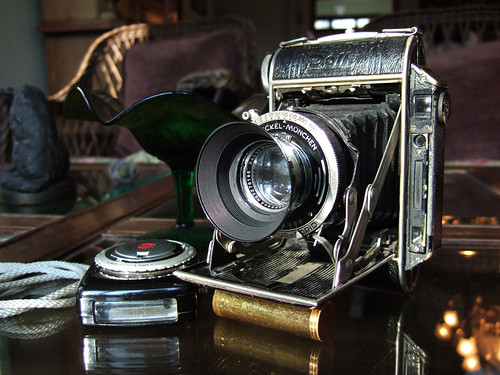Super Sport Dolly

|
| Super Sport Dolly, 4.5×6cm and 6×6cm, coupled rangefinder Schneider Xenar 7.5cm f/2.8 lens, Compur-Rapid shutter. image by Nesster (Image rights) |
The Super Sport Dolly is a self-erecting folding camera for 120 film, produced in the late 1930s by the German maker Certo based in Dresden. The camera can make 4.5×6cm or 6×6cm images, by inserting the correct mask in the film chamber (either format requires a mask, which is combined with a pair of film rollers). Viewfinder and coupled rangefinder models were offered at the same time. There was a version of the camera which could also use 4.5×6 cm plates or a film-pack adapter. Finally, some models have a removable lens and shutter unit, allowing the use of an extension tube, or even exchangeable with a telephoto lens.
Viewfinder model
The viewfinder model has a folding reverse-Galilean viewfinder on the side and either front-cell focusing or unit focusing. It can make 6×6cm or, by changing the mask in the film chamber, 4.5×6cm exposures. Documented with the following lenses, all uncoated, and with front-element focusing:
- Carl Zeiss Tessar f/2.8 7.5cm [1]
- Schneider Xenar f/2.8 7.5cm (this is the five-element Xenar)
- Meyer Görlitz Trioplan f/2.9 7.5cm [2]
  
|
| Super Sport Dolly, 4.5×6cm and 6×6cm, viewfinder model with Tessar 7.5cm f/2.8 lens and Compur shutter. Pictures by eBayer Yalluflex. (Image rights) |

|
| Certo catalogue, c.1938, showing the viewfinder model. (Image rights) |
Model C, for plates and rollfilm
The model C can take 4.5×6cm film plates too, via an insert on the back. There is a lever under the lens to adjust the position of the front standard for proper focusing when switching from one medium to the other.

|

|

| |

| |
| Super Sport Dolly model C, viewfinder only, Trioplan 7.5cm f/2.9 lens, Compur shutter. Pictures by eBayer Yalluflex. (Image rights) | |

|
    
|
| Super Sport Dolly model C outfit, with exposure masks, ground glass viewer and plate holders. Pictures by eBayer Yalluflex. (Image rights) |
 
|
| Lever switching the focusing distance for plates or rollfilm. Pictures by eBayer Yalluflex. (Image rights) |
Rangefinder model
The first (and more common) coupled rangefinder model has the rangefinder combined with a separate viewfinder and an extinction meter in a unit fastened on the side. The lens is either a Xenar or Tessar (uncoated); it always has unit focusing by a helical placed behind the shutter. The focus control is a lever above the shutter; the camera will only fold when this is close to infinity. The shutter release is still on the shutter.
   
|
| Super Sport Dolly, 4.5×6cm and 6×6cm, coupled rangefinder, Tessar 7.5cm f/2.8 lens, Compur shutter. Pictures by eBayer Yalluflex. (Image rights) |

|
| Certo catalogue, c.1938, showing the rangefinder model. (Image rights) |

|
| Instruction manual for the Super Sport Dolly (front page). Picture by eBayer Yalluflex. (Image rights) |
Links
In French:
- Pages on www.collection-appareils.fr by Sylvain Halgand:
- Super Sport Dolly, viewfinder only, Tessar 7.5cm f/2.8, Compur
- Super Sport Dolly model C, viewfinder only, Trioplan 7.5cm f/2.9, Compur
- Super Sport Dolly model C, coupled rangefinder, Xenar 7.5cm f/2.8, Compur
Notes
- ↑ Image by rebollo_fr
- ↑ on-line auction